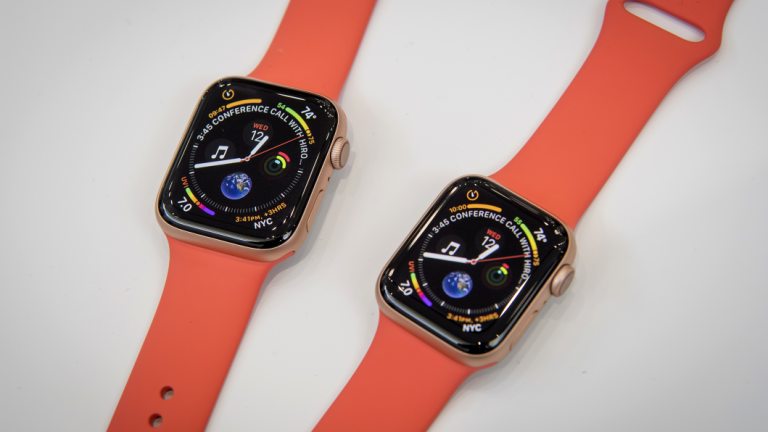The evolution of the smartwatch has been fascinating to track. The first modern smartwatch was arguably the Pebble (rest in peace), unveiled back in 2012. Sony and Samsung were in the race early too, but Google brought the idea into the mainstream and really defined what a modern smartwatch should be in 2014, with the release of Android Wear.
Apple joined the market in 2015, with a device I thought was confused mess (and it was).
Back then, Google’s software was just so far ahead of Apple, and Google’s willingness to monitor your every move to guess what you might want to see on a tiny screen, contrasted with Apple’s commitment to privacy, gave them a lead I thought Apple could never catch. Apple’s second attempt at Watch was not much better, but it showed the company cared about the device, and were working hard to improve it.
The Apple Watch Series 4 is bigger, louder and more powerful, but it’s the improved software that’s the star.
Like the fable of the hare and the tortoise, Apple has continued to iterate on its design, while Google seems to have abandoned the race. Today, Apple is miles ahead, with Samsung’s Gear Watch a distant second but still the best choice for Android users. Android Wear, now called Wear OS by Google, is far behind both.
Last year’s Apple Watch Series 3 was a massive leap forward, in both hardware and software. Series 3 introduced much better battery life — lasting almost two days if you’re not that active — GPS if you are active, and the ability to stream music over mobile networks.
Apple is now competing with itself, and the Series 4 is leaps ahead again. The hardware is fast enough that no interaction has lag, be it flicking your wrist to turn on the screen, or tapping a complication to launch an app.
The screen on the Apple Watch 4 has been redesigned with a bezel-free, edge-to-edge display that fits more on the screen. The two new Infographic watch faces that take advantage of all this space can fill the watch with an almost overwhelming amount of information. But, of course, you don't need to fill every spot.
Apple says the speakers in the Watch are 50 per cent louder, and they are, shockingly so at first. While this makes phone calls direct from the Watch a much better experience, Siri’s responses are so loud I’m now too self-conscious to ask her anything on a crowded train. Thankfully you can turn her down a little in Settings, or muffle her with your hand.
Apple has emphasised overall health this year as the key selling point, not just fitness. A much talked about new feature is fall detection — which should sell a lot of Apple Watches to aging parents and grandparents — but possibly also in manufacturing industries and the like.
Unfortunately one new feature, which allows the Watch to act as an electrocardiogram (or ECG) for measuring heart health, is exclusive to the US for now and will not be enabled here until it receives regulatory approval.
The new walkie-talkie app (which was first mentioned back in the Apple Watch preview event in 2014) is really fun, and while I can see my friends abusing it this is another little feature that could be very handy in industries like hospitality or construction, where people are often on their feet, with full hands.
The Series 4 is compelling for those who can afford it (starting at $599, or $749 for the model with mobile connectivity), and feels like the hardware has headroom for many more features in future updates to the software. But that software is really where many of the improvements are happening, and so the Apple Watch Series 3, now discounted to $399, could be a great entry point into smartwatches.
The key selling point for wearables has always been fitness, and Apple has been slowly improving its fitness credentials. Closing your rings was a simple concept, and completely addictive, but it lacked the social aspect of fitness leader Fitbit. With watchOS 5, Apple has added weekly challenges to the Rings, letting you compete against friends; not for a specific goal, but based on your personal level of fitness. This levels the playing field if your Apple Watch friends are much fitter than you. With weekly challenges, Apple has added the one thing I missed from Fitbit. Rest in peace, Fitbit.
Apple Watch is already a great music player, able to sync your favourite songs overnight, and stream music on the go from Apple Music with a mobile data plan. But the big question for me remains Spotify, the most popular streaming service worldwide, and in our home.
Samsung’s Gear Sport launched with offline Spotify support in 2017, and it will be interesting to see if Spotify are locked into an exclusive deal with Samsung, or if they will release an offline Apple Watch app. My hope is the latter, and if you have an Apple Watch and a Spotify subscription, start demanding an app today.
But for me the biggest improvement is podcast support, which Apple is pushing out to all Watches from Series 1 up, which finally makes the prospect of leaving my phone behind and still having access to entertainment on the go a plausible reality.
Eleven years after the release of the iPhone, Apple’s most important product offers only incremental improvements with each new update. This seems to disappoint pundits, who demand giant leaps in technology with every release. But those wanting year over year drastic improvement need only look at the Apple Watch, which shows no signs of slowing down.
Source: Read Full Article
